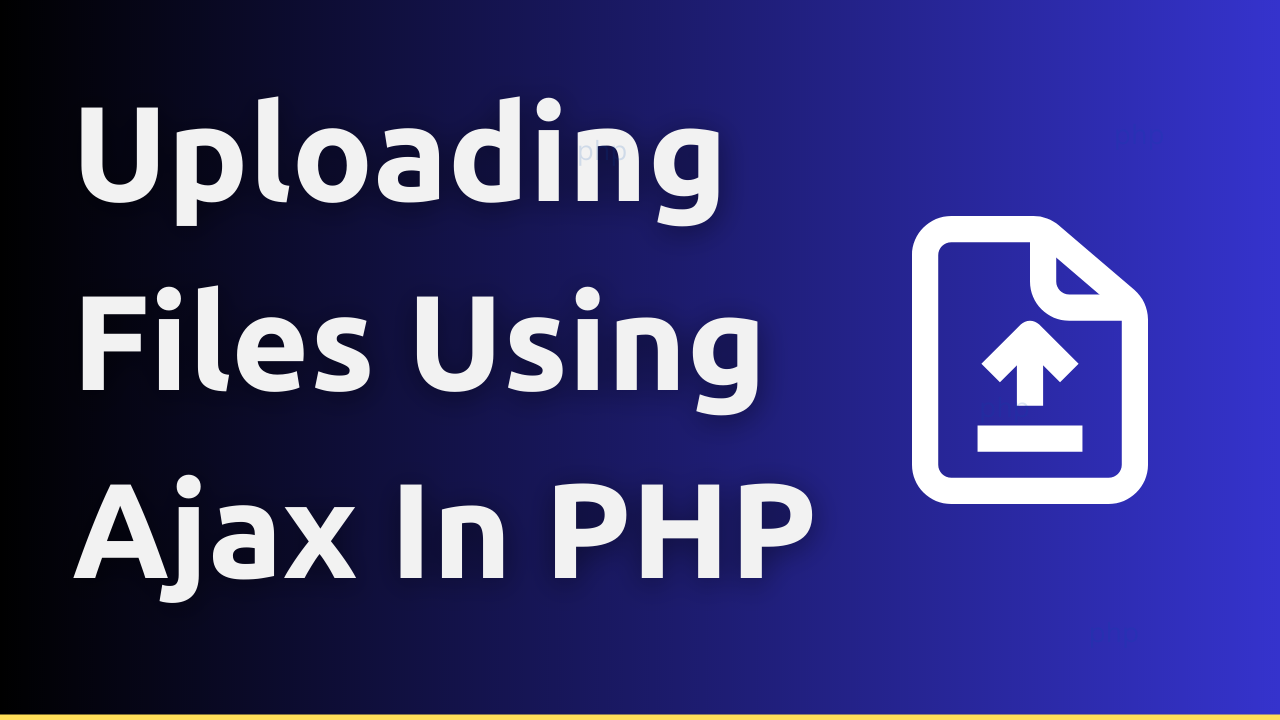Hello readers!
Uploading files to the server is a common task in web development. In the past, it was done using traditional form submissions, which required a page reload and was not very user-friendly. Nowadays, with the help of AJAX, we can upload files to the server without reloading the entire page, making the process smoother and more user-friendly. In this blog post, we’ll walk you through the process of uploading files using AJAX in PHP.
Create Html Form
To start, we need to create an HTML form with an input field for the file, a submit button, and a div element to display the response from the server. Here’s an example:
<form id="uploadForm" enctype="multipart/form-data">
<input type="file" name="file" id="file">
<button type="submit">Upload</button>
</form>
<div id="response"></div>
Write Javascript/JQuery Code
Next, we need to use JavaScript to send an AJAX request to the server to handle the file upload. We’ll use the FormData object to append the file data and send it to the server. Here’s an example:
$(document).ready(function(){
$('#uploadForm').on('submit', function(e){
e.preventDefault();
var formData = new FormData(this);
$.ajax({
url: 'upload.php',
type: 'POST',
data: formData,
dataType: 'json',
contentType: false,
processData: false,
success: function(response){
$('#response').html(response.message);
}
});
});
});
Code Explained
In the code above, we first prevent the default form submission behavior using e.preventDefault(). We then create a new FormData object and append the file data to it using new FormData(this). We then send an AJAX request to the server using the $.ajax() function. The url the parameter specifies the URL of the server-side script that will handle the file upload. We set the type parameter to <strong>POST</strong>, and the data parameter to the FormData object. We set the dataType parameter to <strong>json, and the contentType </strong> processData parameters to false to ensure that the file data is sent correctly. Finally, we display the response from the server in the response div element using <strong>$('#response').html(response.message)</strong>.
Lastly, we need to create a PHP script to handle the file upload on the server side. We’ll use the <mark style="background-color:rgba(0, 0, 0, 0)" class="has-inline-color has-vivid-red-color">move_uploaded_file()</mark> function to move the uploaded file to a specified directory on the server. Here’s an example:
<?php
if(isset($_FILES['file'])){
$targetDir = "uploads/";
$fileName = $_FILES['file']['name'];
$targetFilePath = $targetDir . $fileName;
if(move_uploaded_file($_FILES['file']['tmp_name'], $targetFilePath)){
$response['status'] = 'success';
$response['message'] = 'File uploaded successfully';
}else{
$response['status'] = 'error';
$response['message'] = 'Error uploading file';
}
echo json_encode($response);
}
?>
In the PHP script above, we first check if a file was uploaded using <mark style="background-color:rgba(0, 0, 0, 0)" class="has-inline-color has-vivid-red-color">isset($_FILES['file'])</mark>. We then specify the target directory for the uploaded file using $targetDir, and the file name using <mark style="background-color:rgba(0, 0, 0, 0)" class="has-inline-color has-vivid-red-color">$fileName</mark>. We then use <mark style="background-color:rgba(0, 0, 0, 0)" class="has-inline-color has-vivid-red-color">move_uploaded_file()</mark> it to move the uploaded file to the target directory.
If the file is uploaded successfully, we set the status parameter to success and the message parameter to 'File uploaded successfully'.
If there is an error in uploading the file, we set the `status` parameter to error and the message parameter to 'Error uploading file'.
Finally, we use <mark style="background-color:rgba(0, 0, 0, 0)" class="has-inline-color has-vivid-red-color">json_encode()</mark> to encode the response as a JSON object and return it to the AJAX request.
And that’s it! With these steps, you can upload files using AJAX in PHP. Remember to set appropriate permissions for the target directory to ensure that files can be uploaded successfully.
I hope this blog post was helpful in understanding how to upload files using AJAX in PHP. Feel free to leave any questions or comments below. Happy coding!
Related: PHP Interview Questions, 5 ways to improve your ajax performance
Conclusion
In summary, we have learned how to upload files using AJAX in PHP. This technique allows us to upload files without reloading the page, making the process smoother and more user-friendly. By following the steps outlined in this blog post, you can easily implement file uploads using AJAX in your PHP projects. Remember to create an HTML form, use JavaScript to send an AJAX request to the server, and create a PHP script to handle the file upload on the server side. Happy coding!

